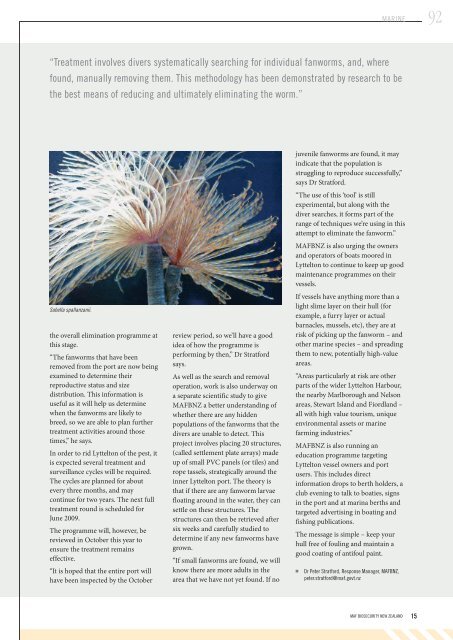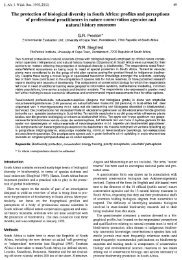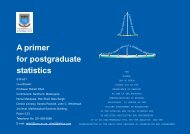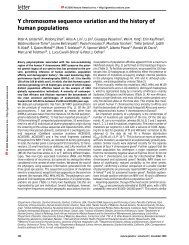Biosecurity magazine - Biosecurity New Zealand
Biosecurity magazine - Biosecurity New Zealand
Biosecurity magazine - Biosecurity New Zealand
You also want an ePaper? Increase the reach of your titles
YUMPU automatically turns print PDFs into web optimized ePapers that Google loves.
MARINE<br />
92<br />
“Treatment involves divers systematically searching for individual fanworms, and, where<br />
found, manually removing them. This methodology has been demonstrated by research to be<br />
the best means of reducing and ultimately eliminating the worm.”<br />
Sabella spallanzanii.<br />
the overall elimination programme at<br />
this stage.<br />
“The fanworms that have been<br />
removed from the port are now being<br />
examined to determine their<br />
reproductive status and size<br />
distribution. This information is<br />
useful as it will help us determine<br />
when the fanworms are likely to<br />
breed, so we are able to plan further<br />
treatment activities around those<br />
times,” he says.<br />
In order to rid Lyttelton of the pest, it<br />
is expected several treatment and<br />
surveillance cycles will be required.<br />
The cycles are planned for about<br />
every three months, and may<br />
continue for two years. The next full<br />
treatment round is scheduled for<br />
June 2009.<br />
The programme will, however, be<br />
reviewed in October this year to<br />
ensure the treatment remains<br />
effective.<br />
“It is hoped that the entire port will<br />
have been inspected by the October<br />
review period, so we’ll have a good<br />
idea of how the programme is<br />
performing by then,” Dr Stratford<br />
says.<br />
As well as the search and removal<br />
operation, work is also underway on<br />
a separate scientific study to give<br />
MAFBNZ a better understanding of<br />
whether there are any hidden<br />
populations of the fanworms that the<br />
divers are unable to detect. This<br />
project involves placing 20 structures,<br />
(called settlement plate arrays) made<br />
up of small PVC panels (or tiles) and<br />
rope tassels, strategically around the<br />
inner Lyttelton port. The theory is<br />
that if there are any fanworm larvae<br />
floating around in the water, they can<br />
settle on these structures. The<br />
structures can then be retrieved after<br />
six weeks and carefully studied to<br />
determine if any new fanworms have<br />
grown.<br />
“If small fanworms are found, we will<br />
know there are more adults in the<br />
area that we have not yet found. If no<br />
juvenile fanworms are found, it may<br />
indicate that the population is<br />
struggling to reproduce successfully,”<br />
says Dr Stratford.<br />
“The use of this ‘tool’ is still<br />
experimental, but along with the<br />
diver searches, it forms part of the<br />
range of techniques we’re using in this<br />
attempt to eliminate the fanworm.”<br />
MAFBNZ is also urging the owners<br />
and operators of boats moored in<br />
Lyttelton to continue to keep up good<br />
maintenance programmes on their<br />
vessels.<br />
If vessels have anything more than a<br />
light slime layer on their hull (for<br />
example, a furry layer or actual<br />
barnacles, mussels, etc), they are at<br />
risk of picking up the fanworm – and<br />
other marine species – and spreading<br />
them to new, potentially high-value<br />
areas.<br />
“Areas particularly at risk are other<br />
parts of the wider Lyttelton Harbour,<br />
the nearby Marlborough and Nelson<br />
areas, Stewart Island and Fiordland –<br />
all with high value tourism, unique<br />
environmental assets or marine<br />
farming industries.”<br />
MAFBNZ is also running an<br />
education programme targeting<br />
Lyttelton vessel owners and port<br />
users. This includes direct<br />
information drops to berth holders, a<br />
club evening to talk to boaties, signs<br />
in the port and at marina berths and<br />
targeted advertising in boating and<br />
fishing publications.<br />
The message is simple – keep your<br />
hull free of fouling and maintain a<br />
good coating of antifoul paint.<br />
■<br />
Dr Peter Stratford, Response Manager, MAFBNZ,<br />
peter.stratford@maf.govt.nz<br />
MAF BIOSECURITY NEW ZEALAND 15
















